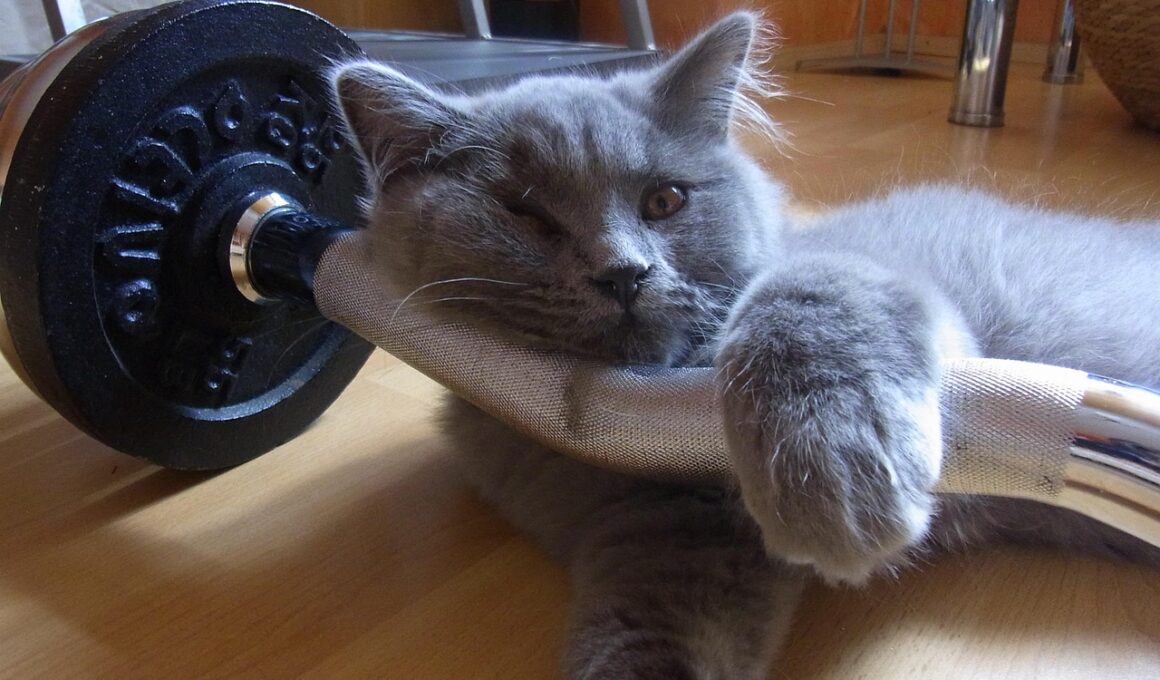How to Teach Your Cat Tricks Using Positive Reinforcement
Teaching your cat tricks can be an enjoyable experience for both of you. One of the most effective methods is using positive reinforcement, which rewards desired behaviors instead of punishing unwanted ones. Start by choosing a simple trick, such as ‘sit’ or ‘high five.’ Ensure you have tasty treats or their favorite toy ready as rewards. Timing is critical; reward your cat immediately after they perform the trick. This helps them to associate the behavior with the reward. Be patient and remember that every cat learns at their own pace. Short training sessions, around five to ten minutes, can be beneficial. This helps keep the cat engaged and prevents frustration, both for you and the animal. Cats thrive on consistency, so practice the trick regularly to reinforce their learning. Experiment with different treats or toys to keep the sessions exciting. And remember to always keep the atmosphere light and fun; your cat will respond better when they enjoy the process. Positive training can strengthen your bond while enhancing your cat’s ability to learn new tricks!
Before embarking on training, it’s essential to understand feline behavior. Cats are naturally curious and often explore their environment. Utilizing their instincts during training can yield better results. Engage their playfulness and offer them a challenge by rewarding them for using their skills. When using positive reinforcement, be sure to acknowledge even the slightest progress to encourage further learning. Avoid any actions that could scare or intimidate your cat, as trust is foundational for effective training. The environment plays a vital role; a quiet, distraction-free space can enhance learning capabilities. Providing a comfortable surface can support their training experience. If they tire or lose interest, it’s essential to take a break and not push them too hard. Always make sure to vary the treats or stimuli you use to maintain their interest. Using a clicker can help signal to the cat the moment they have done something right. This sound adds clarity and helps them recognize the link between the action and the reward. Constant encouragement is key; be their cheerleader to enhance their confidence while learning!
Choosing the Right Treats for Training
Selecting the right treats is crucial when training your cat. Opt for small, bite-sized options that can quickly be consumed to maintain training momentum. Foods with a stronger smell can be more enticing and may prompt faster responses during sessions. Experimenting with various textures and flavors will keep your cat engaged and motivated to learn. Some cats respond better to crunchy treats, while others prefer softer options. If your cat is particularly picky, adding a few fresh pieces of cooked chicken or tuna can elevate their enthusiasm. During this phase, avoid giving them large portions, as you want to prevent obesity. Pay attention to their reactions; if they show excitement for a particular treat, consider making it a go-to reward. Additionally, remember that treats should not exceed more than 10% of their daily caloric intake. Doing so maintains a healthy balance while still rewarding your cat. Over time, you can gradually reduce the treat quantity as your cat learns the tricks, and use verbal praise in place of treats to maintain their motivation!
Consistency is key in training cats. Having a uniform command for each trick helps the cat understand what is expected. For instance, always use the same word for ‘sit.’ Repeating the command clearly helps the cat connect the sound with the action. Using consistent body language and gestures while offering the reward will further reinforce learning. Also, it’s not necessary to train a variety of tricks at once. One new trick at a time will keep your sessions focused and productive. Consider adopting a sequential approach; once the cat masters one trick, you can then introduce another. Staying upbeat and using a gentle tone will motivate them to try harder. While positive reinforcement rewards successful behavior, it’s equally important to remain patient through any mistakes. Cats, like humans, can sometimes be moody; some days they may not be interested in training at all, and it’s crucial to recognize this. Frequent repetition and gradual exposure will help them learn, leading to a trust-based relationship that makes training a joyful experience!
Tips to Make Training Fun
Incorporating fun into training sessions can enhance your cat’s learning experience significantly. Utilize their favorite toys, such as dangling strings or laser pointers, to invoke excitement. Engage in playful interaction and include short bursts of playtime as rewards for completing a trick. Make training part of a game, where they think of it as an enjoyable activity rather than a chore. Always allow breaks during the session to prevent burnout. If they are fully engaged, consider rewards outside treats, like extra cuddle time. Additionally, integrating training into their feeding time could create a more instinctual association with positive reinforcement. For example, guide your cat to perform tricks before meals. The anticipation of food can motivate and excite them to learn and perform. It’s essential to listen to your cat’s mood; flexibility within your structure can go a long way. An enjoyable learning environment will enhance their desire to respond to commands. The joy they experience can lead to quicker learning and create a lasting bond based on interaction and trust that continues beyond training!
Monitoring your cat’s progress can provide insight into how well the training is going. Keeping a journal to note their successes can help identify patterns, including what works and what doesn’t. This documentation can track how long it takes for the cat to learn different tricks. Reflect on your approach, adjusting methods as necessary based on the cat’s performance. Consider engaging friends or family to observe training sessions; they can provide additional feedback and encouragement. Regularly celebrating milestones, regardless of how small, will create a positive atmosphere that promotes further learning. After considerable practice, consider staging small tests to see if your cat will perform without immediate rewards. This can gauge their mastery of the trick. In the long term, you may want challenges that incorporate multiple tricks in an enjoyable setting. Keeping training sessions light-hearted and fun can prevent the experience from becoming monotonous. A successful training regimen never ends; it evolves and adapts as your cat masters new skills, fulfilling both your expanded expectations and their changing abilities.
Conclusion: Enjoying the Bond
Positive reinforcement can lead to a rewarding experience for both you and your cat. The skills gained through learning tricks not only stimulate your cat mentally but also strengthen the bond between you. Consistent training nurtures a trusting relationship that extends beyond simple commands. By engaging in this process regularly, you will notice improved communication and a harmonious environment. Always celebrate each achievement, as small as they may be. When your cat performs tricks or behaviors that please you, it creates a joyful interaction and happiness. The combined effort of patience, reward, and love will ultimately lead to a cat eager to learn more and participate in activities. When your feline friends feel secure and appreciated, they will likely keep you entertained with their newfound skills. The training journey is not just about the tricks; it’s about fostering an enriching relationship for both of you. Cherishing this time and seeing your cat thrive will be rewarding. Embrace this unique learning opportunity and discover a new realm of companionship with your furry friend!
Through each training session, aim to deepen your connection with your cat, understanding their needs and quirks. Elevate the joy of learning for both of you, creating lifelong memories around simple tricks. Whether teaching ‘roll over’ or ‘fetch,’ the collaborative effort can offer mutual satisfaction. The ultimate goal of training with positive reinforcement is to enhance your bond and make your shared life more enjoyable. A well-trained cat is often happier and more adjusted, leading to a peaceful household. Training exercises contribute positively to their mental health, keeping boredom at bay. Thus, engaging them in enriching activities can help them develop a wonderful personality. The joy of seeing your cat perform well can fill you with pride. It’s an opportunity to showcase what they’ve learned and how far they’ve come. With each trick mastered, appreciate the uniqueness of your cat and celebrate your evolving relationship. Ultimately, the skills learned through positive reinforcement reflect the kindness and compassion you share, establishing a foundation of trust and love that will last.


